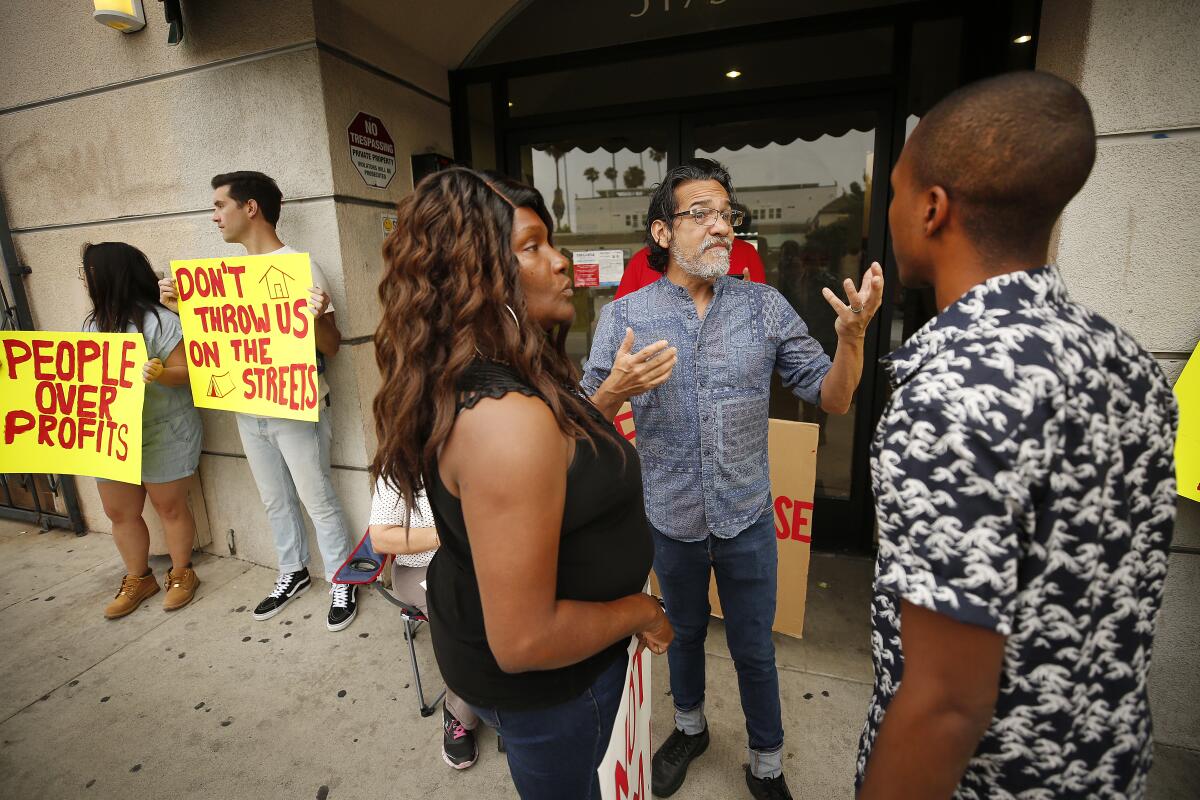L.A. needs to preserve affordable housing. Eminent domain isn’t the way to do it

- Share via
These are desperate times for Los Angeles.
Even as the city, county and state have been pouring money into housing and services, the number of people living on the street has gone steadily up. More and more of them are losing their housing — often for the first time — because of unaffordable rents and evictions.
But are we ready for desperate measures?
Councilman Gil Cedillo says yes. He has proposed using the power of eminent domain to force a landlord in Chinatown to sell his building to the city in order to preserve affordable apartments. If it works, Cedillo wants the city to consider seizing other privately-owned buildings whose owners are on the cusp of converting their rents from below-market to market rate.
The building in Chinatown, Hillside Villa Apartments, was constructed in the 1980s with a loan from the Community Redevelopment Agency. Under the terms of the loan, the apartments must be kept affordable to low-income tenants for 30 years. That agreement is now about to expire, and the owner, Tom Botz, wants to convert about half of the units to market rates in September. (The tenants in the other units have Section 8 vouchers.) For some longtime tenants, the increase to market rate will double their current rent, and they’ll be forced to find a new home in L.A.’s staggeringly unaffordable housing market.
Under eminent domain, governments can force owners to sell their private property in order to put it to a public use, in return for fair-market compensation. Cedillo says he is turning to this extreme measure only as a last resort. He, along with tenant advocates, spent months trying to convince Botz to keep the apartments affordable for another 10 years. In exchange, Cedillo’s office said, the city offered to forgive the remaining development loan used to build the property and to compensate Botz for revenue he lost by keeping the rents below market rate.
Still, Botz rejected the deal, telling reporters that the city and the building’s tenants would probably demand another extension in 10 years, which is a likely scenario. Botz argues that he has fulfilled his 30-year commitment to keep rates low and that he now has a right to profit from his investment. He also argues that the threat of eminent domain will deter for-profit developers from partnering with the city on affordable housing projects in the future. Part of the calculation developers and investors make when deciding whether back a project is its earning potential after the convenant expires.
Eminent domain has been aptly compared to J.R.R. Tolkien’s “ring of power” — an enormously powerful and tempting tool that can be life-saving in the moment, but is ultimately corrupting and best avoided. In L.A., eminent domain has a long and sometimes troubled history, starting with its use to clear Chavez Ravine to make way for Dodger Stadium, and later to replace homes and businesses with hotels and shopping centers in redevelopment areas.
Activists argue that it’s about time the city used this power to help vulnerable tenants rather than wealthy real estate investors. Eminent domain requires that the government pay fair market value for private property, and affordable housing is certainly an important public use, especially now in a housing and homelessness crisis. In the Seattle area, the King County Housing Authority has used the threat of eminent domain — and sometimes has actually followed through — to buy and preserve thousands of units of affordable housing in gentrifying communities over the last 30 years.
Yet L.A. leaders cannot ignore the possible repercussions if the city were to seize private property for affordable housing simply because the need for those units is so great. It could scare away the private and for-profit developers that L.A. relies upon to build much-needed housing, as well as the investors who help fund the construction in the first place. It also could undermine public support for the city’s ambitious, taxpayer-supported programs to build homeless and affordable housing. Private property rights are a bedrock American value, and eminent domain has long been deeply unpopular.
What’s especially frustrating is that the plight of Hillside Villa residents should come as no surprise to City Hall. For more than a decade, L.A. officials have talked about creating a “preservation strategy” to deal with the more than 11,000 rent-restricted apartments that could move to market rate in the coming years. Yet here we are today, pondering extreme “last-resort” options.
There are other ways to preserve affordable housing, but they require political support and money. Assemblyman Jesse Gabriel (D-Woodland Hills) has introduced Assembly Bill 2058, which would create a new $500-million tax credit that could help preserve 25,000 rent-restricted units that would otherwise convert to market rent. The funding could help nonprofits buy buildings with expiring affordability agreements and keep the apartments affordable and the tenants in place — without trampling on private property rights.
More to Read
A cure for the common opinion
Get thought-provoking perspectives with our weekly newsletter.
You may occasionally receive promotional content from the Los Angeles Times.









